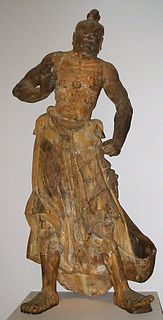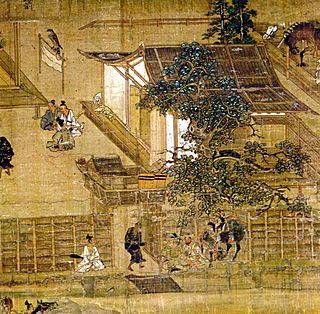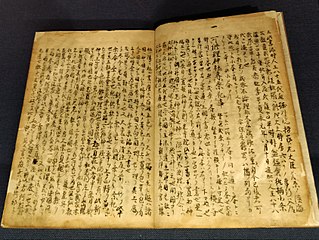The Hikitsuke (引付 lit. enquiry) or Hikitsuke-kata (引付方) (High Court) was one of the judicial organs of the Kamakura and Muromachi shogunates of Japan.

The Kamakura shogunate was a Japanese feudal military government of imperial-aristocratic rule that ruled from 1185 to 1333. The heads of the government were the shōguns. The first three were members of the Minamoto clan. The next two were members of the Fujiwara clan. The last six were minor Imperial princes.

Japan is an island country in East Asia. Located in the Pacific Ocean, it lies off the eastern coast of the Asian continent and stretches from the Sea of Okhotsk in the north to the East China Sea and the Philippine Sea in the south.
The Hikitsuke was established by the fifth shikken Hōjō Tokiyori in 1249 [1] to expedite an increasing number of lawsuits in the higher Hyojosho court. The Hikitsuke was responsible for establishing the facts of a case, while the Hyojosho would interpret the applications of law. [1]
The shikken was a titular post held by a member of Hōjō clan, officially a regent of the shogunate, from 1199 to 1333, or during the Kamakura period, therefore it was head of the bakufu (shogunate). It was part of the era referred to as Regent Rule.

Hōjō Tokiyori was the fifth shikken (regent) of the Kamakura shogunate in Japan.
The Hikitsuke had three, and later five, tribunals; each tribunal was operated by four or five Hikitsukeshū (引付衆 adjusters), whose head was called a Tōnin (頭人), with four or five Bugyōnin (奉行人 secretaries).
The Hikitsuke's power increased gradually. At first the Hikitsuke just drafted several verdicts after hearings and submitted them to the Hyojoshu. Submitting only one verdict per lawsuit, the Hikitsuke later became a de facto full law court. It originally processed only conflicts of the vassals of the shogunate, but later treated more general cases.[ citation needed ]

A gokenin (御家人) was initially a vassal of the shogunate of the Kamakura and the Muromachi periods. In exchange for protection and the right to become shugo (governor) or jitō, in times of peace a gokenin had the duty to protect the imperial court and Kamakura, in case of war had to fight with his forces under the shōgun’s flag. From the middle of the thirteenth century, the fact that gokenin were allowed to become de facto owners of the land they administered, coupled to the custom that all gokenin children could inherit, brought to the parcelization of the land and to a consequent weakening of the shogunate. The gokenin class ceased to be a significant force during the Muromachi period and was supplanted by the figure of the daimyō. During the successive Edo period, the term finally came to indicate a direct vassal of the shōgun below an omemie (御目見), meaning that they did not have the right to an audience with the shōgun.
Although it aimed at accelerating trials and making them fair, the Hikitsuke tended to make rough-and-ready decisions in the late Kamakura period. The Hikitsukeshu were mostly occupied by the Hōjō clan. In addition, the Hikitsukeshu and Hyojoshu lost effective power to the yoriai, which was held at tokuso's residence.

The Kamakura period is a period of Japanese history that marks the governance by the Kamakura shogunate, officially established in 1192 in Kamakura by the first shōgun, Minamoto no Yoritomo. The period is known for the emergence of the samurai, the warrior caste, and for the establishment of feudalism in Japan.

The Hōjō clan in the history of Japan was a family who controlled the hereditary title of shikken (regent) of the Kamakura shogunate between 1203 and 1333. Despite the title, in practice the family wielded actual governmental power during this period compared to both the Kamakura shōguns, or the Imperial Court in Kyoto, whose authority was largely symbolic. The Hōjō are known for fostering Zen Buddhism and for leading the successful opposition to the Mongol invasions of Japan. Resentment at Hōjō rule eventually culminated in the overthrow of the clan and the establishment of the Ashikaga shogunate.
The Muromachi shogunate took over the system of Hikitsuke, but it lost its substantial meaning after Ashikaga Tadayoshi died, who controlled the Hikitsuke.

Ashikaga Tadayoshi was a general of the Northern and Southern Courts period (1337–92) of Japanese history and a close associate of his elder brother Takauji, the first Muromachi shōgun. Son of Ashikaga Sadauji and Uesugi Kiyoko, daughter of Uesugi Yorishige, the same mother as Takauji, he was a pivotal figure of the chaotic transition period between the Kamakura and Muromachi shogunates. Tadayoshi is today considered a military and administrative genius and the true architect of many of his elder brother's successes. In contemporary chronicles he is rarely called with his name, but is instead called either gosho (御所) or Daikyū-ji-dono (大休寺殿) from the name of his family temple. His posthumous name was Kozan Egen (古山慧源).







